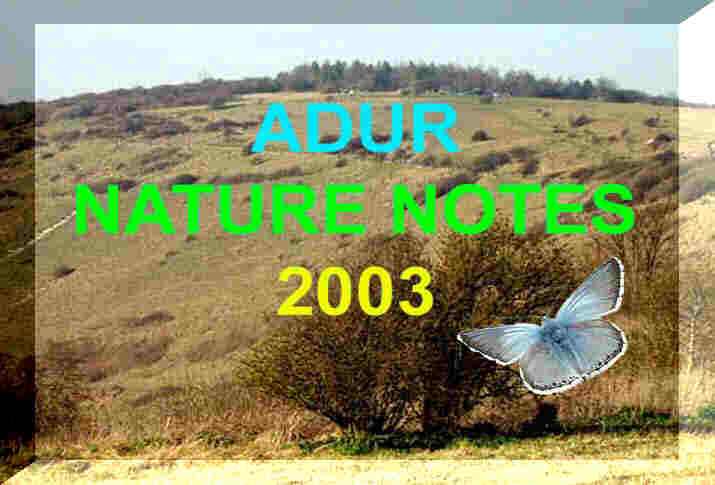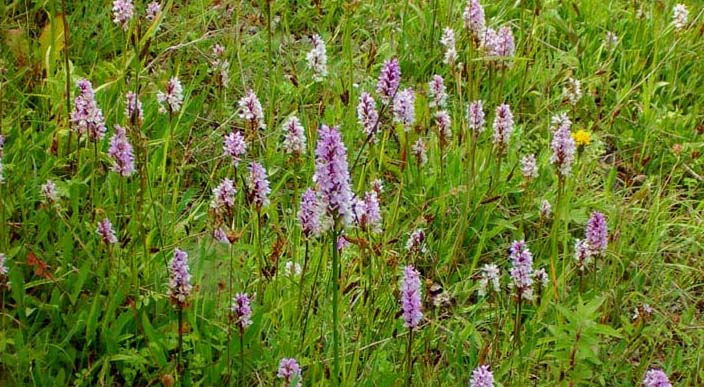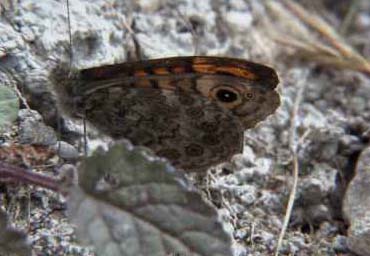 |
| Coastal Fringe |
| Chalk Downs: Mill Hill |
| Intertidal (Seashore) |
| River Adur Estuary |
| River Adur Flood Plain |
| Sea (off Sussex) |
| Town & Gardens |
| Widewater Lagoon |
| Lancing Ring (Nature) |
 |
| SUSSEX LINKS |
| Findon Village |
| Rye Harbour Nature Reserve |
| Sussex
Archaeology &
Folklore |
| Lancing (RH) |
|
|
 |
|
|
 |
Looking
down the bridleway from Stonechat Junction (midway between Southwick Hill
and Mossy Bottom Barn) (TQ 225 078)
towards Slonk Hill
|
|
Southwick
Hill
including Slonk
Hill, Mossy Bottom
and Thundersbarrow
Link to the Wildlife Reports for 2004 et seq.20 November 2003
At Happy Valley (behind Slonk Hill), Shoreham, two Stonechats were recorded. New Erringham Farm produced a flock of about 25 Corn Buntings, plus a further five on the road to Truleigh Hill.Report by Paul James on Sussex Ornithological Society News
All these sightings were also recorded by other observers recently.
16 October 2003
Field Scabious was still in flower on the edge of the bridlepath running north from Slonk Hill. A Pheasant struggled to become airborne on the path leading to Mossy Bottom from the east, where a Clouded Yellow Butterfly fluttered amongst the grasses. Two chirms of Goldfinches numbering over 100 small birds flew around near New Erringham Farm. They preferred to hide in the Hawthorn, but not exclusively.
Silver Y Moth, Autographa gamma This common immigrant moth was seen at Southwick Hill, but it is often seen in the meadows by Lancing Ring
It is a long walk to Southwick Hill and it is pity that more often than not it turns out disappointing, but this time I veered off to the west and found a patch Horseshoe Vetch (not in flower, of course) in a clearing amongst the Gorse, but there was just the one Chalkhill Blue, but this could explain the presence of Adonis Blues in August 2000, but the brightest blue today were Common Blues (25+), the commonest blues on display.
Clouded Yellow Butterfly
They were also the commonest butterflies after the Large Whites (50+), with more than a score of Meadow Browns (including a pair mating in flight) and over a dozen Gatekeepers, with a handful each of Small Tortoiseshells, Speckled Woods (amongst the Gorse), Small Whites (one landed on my bicycle), and at least one Painted Lady, Red Admiral, Wall Brown and Clouded Yellow.
More Images of the Day
23 July 2003
A Brown Argus Butterfly was a surprise discovery on on the Slonk Hill A27 southern embankment (TQ 228 067) with other butterflies including Meadow Browns, Gatekeepers, Red Admirals, Large Whites, one Speckled Wood, a few Chalkhill Blues, and Large Skippers.
On the shallow climb from Slonk Hill Farm north of the hill towards Mossy Bottom, there were at least a dozen Painted Lady Butterflies in bright colours, a single Small Tortoiseshell Butterfly with a bit of its wing missing (in old colouration) as well as the usual Meadow Browns and Gatekeepers. The half a dozen blue flutterings in the long grasses and parched earth with Scabious by the bridlepath were Common Blue Butterflies.
Tortoiseshell Colour LiveriesA Wall Brown Butterfly flew past Mossy Bottom, as simultaneously a couple of Goldfinches perched on the barbed wire.
27 June 2003
Slonk Hill has been cut in half by the A27 by-pass as the dual carriageway truck road (constructed 1971) and the southern area of the hill is now the steep chalky embankments of the dual carriageway.The Spotted Orchids were scattered amongst the long grass and
even the brambles over the area of a large overgrown gardenThe southern bank was adorned like a meadow with an extensive display of Spotted Orchids near the footbridge to Slonk Hill Farm. The bank attracted butterflies including my first Comma Butterfly of the year, a Large White Butterfly with extensive black markings and a handful of aggressive Meadow Browns which tended to chase other butterflies away at any opportunity.
Full Report9 May 2003
The Gorse-lined bridleway from north Southwick (Hawkins Close) to Southwick Hill and Thundersbarrow recorded just three Wall Brown Butterflies and nothing else worth mentioning, unless you count a dozen Jackdaws on the National Trust grazed grassland.

The Stonechats are the small birds on the barbed wire
to the left of the HawthornSo uninteresting that I retraced my steps and took the path down to Mossy Bottom. My attention was drawn to a pair of birds calling stridently from a barbed wire fence by a Hawthorn tree at the junction with the path down to Slonk Hill (TQ 225 078). The male Stonechat was particularly striking with its almost black cap, really quite a red breast and just a glimpse of white on the throat. The male frequently cocked its tail in an upright manner. The female Stonechat was a rather pale brown comparatively, perched only about two metres away on the same wire.
The call of Stonechats are what made me aware of its presence. In this case it may have been my presence that prompted the danger call. The Stonechats seem to perform the role of sentinel like the Redshank on estuaries.
Information Page (Warning Calls)
Biodiversity Action Plan Notes
The understory of the Hawthorn contained the Rock Rose, recognised by the yellow flower and this species of plant is known to the food plant of the caterpillars of the Brown Argus Butterfly. In this location it was inconspicuous, almost lost amongst the grasses. The soil was clay with flints rather than chalk.
At Mossy Bottom I do not know if it was a Sparrowhawk or a Cuckoo which flew rapidly away from me, (and I was looking down on to the upper wings of the bird), to the small copse in the south-west. It was too far away to be sure.
The hovering Kestrel at New Erringham was unmistakable.16 April 2003
From the bare field to the south-west of Southwick Hill the melody of a Skylark filled the air for ten minutes or more without a break. It would need a directional microphone to record the songs because in the distance the hum of the traffic on the A27 could be heard as well as clattering from the dockside at Shoreham Harbour.
The small falcons are not always to separate at a distance, but the blunt-shaped head and swooping flight without hovering, together with the subdued colours (compared to a Kestrel) indicated a male Sparrowhawk at New Erringham Farm in the dip of the downs north of Shoreham.The shirt sleeves sunny weather was unseasonal, recorded at 21° C in the shade and this brought the butterflies out with 50+ Small Tortoiseshell Butterflies from the path north of Slonk Hill past New Erringham to Mill Hill, with 15+ Peacock Butterflies.
A Red-tailed Bumblebee, Bombus lapidarius, crawled into the long grass near Mossy Bottom Barn.A walk on the bridleway (TQ 225 070 - TQ 225 078) from the north side of Slonk Hill to Southwick Hill revealed the first Clouded Yellow Butterflies (8+) since 2000. They were flying around rapidly and would not settle. Unlike the Small Tortoiseshells (100+) which were everywhere settling on Ragwort and the bridleway. Most were brightly coloured, but there some faded ones as well. The Painted Ladies (30+) preferred the Greater Knapweed. Wall Browns (40+) preferred to settle on bare areas of chalk but made fleeting visits to Hardheads.
Gatekeepers (25+), Small Whites (15+), Meadow Browns (15+) and at least one Red Admiral completed the butterfly list.
South Downs Butterflies
Immigration of LepidopteraWall Browns (illustrated) habitually land on rocks and bare chalk
I disturbed a female Sparrowhawk on a fence post, (near some bushes with many small brown birds), which glided magnificently at at a low level across the open field.
Common Darter Dragonflies, Sympetrum striolatum, flew over the latitudinal bridlepath from Mossy Bottom to Southwick Hill (west to east).
Adur Dragonflies5 July 2001
On the long mostly straight steadily uphill path from Southwick Hill to Truleigh Hill, Small Tortoiseshell Butterflies were common (75 +) (possibly including Painted Ladies and Comma Butterflies), but there were also Meadow Browns (30+), Marbled Whites, (25+), Small Skippers (20+) Red Admirals (12+) and an occasional Small White Butterfly in decreasing order of prevalency.22 August 2000
A flinty path leads from the top of Upper Kingston Lane to Southwick Hill under which the main A27 road burrows a large tunnel which is hardly noticeable from the vantage point 121 metres above sea level. A dozen or more Adonis Blue Butterflies (identification confirmed) settled, despite the strong breeze. They were not recognised to be any different from the Chalkhill Blues at the time. It was only later after the photograph was confirmed that a name was put to them. Meadow Brown butterflies were frequently seen and possibly a Comma Butterfly.A pretty little Small Copper Butterfly fed on a yellow flower on the path * going downhill east towards Mossy Bottom and up to New Erringham Farm and Mill Hill. It was harvest time and a pleasant sunny (22 ° C) day without the excessive humidity of late.
Adur Butterflies
Better photographs at a different location
Fungi: Puff-Ball (in August 1999, Shirley Carden of Southwick found a Puff-Ball weighing 4.4 kg (9 lb 12 oz) The location was not revealed.
History of Lancing (Ray Hamblett)
Nature Notes for Lancing Ring
Lancing (RH)
Local Wildlife Links (SE England)
Adur Valley
Adur Butterfly Page
Adur Nature Notes 2003
Adur Valley Wildlife
Chalk Rivers Biodiversity (JNCC)
Cornwall (Geomorphology, Eclipse etc.)
Dungeness, Kent, England
Findon Village
Lancing & Sompting
Orford Ness: Coastal Ecology of a Shingle Bank (excellent references)
Ralph Hollins Nature Pages (Chichester Harbour area)
Rye Harbour Nature Reserve
Rockpooling Page
Seashore Page
Shingle Coast (Coastal Fringe of Shoreham Beach)
Shoreham-by-Sea Wildlife Page
South Downs Way (by Allen Pollard)
Southwick
Sussex Archaeology & Folklore
|
|
|
|
|






